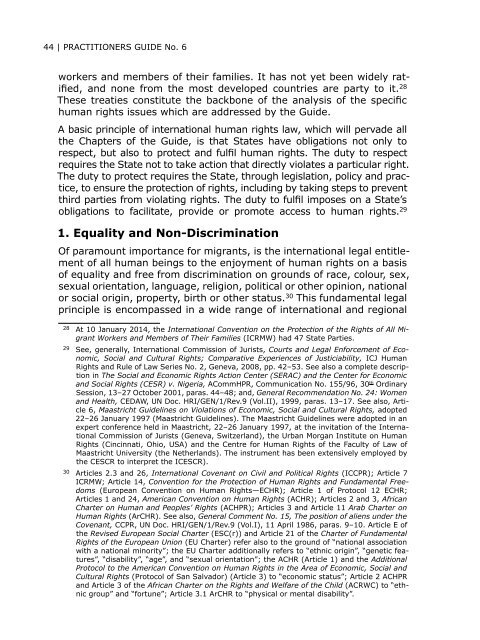Universal-MigrationHRlaw-PG-no-6-Publications-PractitionersGuide-2014-eng
Universal-MigrationHRlaw-PG-no-6-Publications-PractitionersGuide-2014-eng
Universal-MigrationHRlaw-PG-no-6-Publications-PractitionersGuide-2014-eng
You also want an ePaper? Increase the reach of your titles
YUMPU automatically turns print PDFs into web optimized ePapers that Google loves.
44 | PRACTITIONERS GUIDE No. 6<br />
workers and members of their families. It has <strong>no</strong>t yet been widely ratified,<br />
and <strong>no</strong>ne from the most developed countries are party to it. 28<br />
These treaties constitute the backbone of the analysis of the specific<br />
human rights issues which are addressed by the Guide.<br />
A basic principle of international human rights law, which will pervade all<br />
the Chapters of the Guide, is that States have obligations <strong>no</strong>t only to<br />
respect, but also to protect and fulfil human rights. The duty to respect<br />
requires the State <strong>no</strong>t to take action that directly violates a particular right.<br />
The duty to protect requires the State, through legislation, policy and practice,<br />
to ensure the protection of rights, including by taking steps to prevent<br />
third parties from violating rights. The duty to fulfil imposes on a State’s<br />
obligations to facilitate, provide or promote access to human rights. 29<br />
1. Equality and Non-Discrimination<br />
Of paramount importance for migrants, is the international legal entitlement<br />
of all human beings to the enjoyment of human rights on a basis<br />
of equality and free from discrimination on grounds of race, colour, sex,<br />
sexual orientation, language, religion, political or other opinion, national<br />
or social origin, property, birth or other status. 30 This fundamental legal<br />
principle is encompassed in a wide range of international and regional<br />
28 At 10 January <strong>2014</strong>, the International Convention on the Protection of the Rights of All Migrant<br />
Workers and Members of Their Families (ICRMW) had 47 State Parties.<br />
29 See, generally, International Commission of Jurists, Courts and Legal Enforcement of Eco<strong>no</strong>mic,<br />
Social and Cultural Rights; Comparative Experiences of Justiciability, ICJ Human<br />
Rights and Rule of Law Series No. 2, Geneva, 2008, pp. 42–53. See also a complete description<br />
in The Social and Eco<strong>no</strong>mic Rights Action Center (SERAC) and the Center for Eco<strong>no</strong>mic<br />
and Social Rights (CESR) v. Nigeria, ACommHPR, Communication No. 155/96, 30 th Ordinary<br />
Session, 13–27 October 2001, paras. 44–48; and, General Recommendation No. 24: Women<br />
and Health, CEDAW, UN Doc. HRI/GEN/1/Rev.9 (Vol.II), 1999, paras. 13–17. See also, Article<br />
6, Maastricht Guidelines on Violations of Eco<strong>no</strong>mic, Social and Cultural Rights, adopted<br />
22–26 January 1997 (Maastricht Guidelines). The Maastricht Guidelines were adopted in an<br />
expert conference held in Maastricht, 22–26 January 1997, at the invitation of the International<br />
Commission of Jurists (Geneva, Switzerland), the Urban Morgan Institute on Human<br />
Rights (Cincinnati, Ohio, USA) and the Centre for Human Rights of the Faculty of Law of<br />
Maastricht University (the Netherlands). The instrument has been extensively employed by<br />
the CESCR to interpret the ICESCR).<br />
30 Articles 2.3 and 26, International Covenant on Civil and Political Rights (ICCPR); Article 7<br />
ICRMW; Article 14, Convention for the Protection of Human Rights and Fundamental Freedoms<br />
(European Convention on Human Rights—ECHR); Article 1 of Protocol 12 ECHR;<br />
Articles 1 and 24, American Convention on Human Rights (ACHR); Articles 2 and 3, African<br />
Charter on Human and Peoples’ Rights (ACHPR); Articles 3 and Article 11 Arab Charter on<br />
Human Rights (ArCHR). See also, General Comment No. 15, The position of aliens under the<br />
Covenant, CCPR, UN Doc. HRI/GEN/1/Rev.9 (Vol.I), 11 April 1986, paras. 9–10. Article E of<br />
the Revised European Social Charter (ESC(r)) and Article 21 of the Charter of Fundamental<br />
Rights of the European Union (EU Charter) refer also to the ground of “national association<br />
with a national mi<strong>no</strong>rity”; the EU Charter additionally refers to “ethnic origin”, “genetic features”,<br />
“disability”, “age”, and “sexual orientation”; the ACHR (Article 1) and the Additional<br />
Protocol to the American Convention on Human Rights in the Area of Eco<strong>no</strong>mic, Social and<br />
Cultural Rights (Protocol of San Salvador) (Article 3) to “eco<strong>no</strong>mic status”; Article 2 ACHPR<br />
and Article 3 of the African Charter on the Rights and Welfare of the Child (ACRWC) to “ethnic<br />
group” and “fortune”; Article 3.1 ArCHR to “physical or mental disability”.



